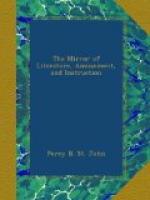Captain B.
however, took up her body to the lake; and not meeting with any
of her people, left it where they were afterwards likely to meet
with it. It appears the Indians were this winter encamped on the
banks of the River Exploits, and observed Captain B.’s party
passing up the river on the ice. They retired from their
encampments in consequence; and, some weeks afterwards, went by
a circuitous route to the lake, to ascertain what the party had
been doing there. They found Mary March’s body, and removed it
from where Captain B. had left it to where it now lies, by the
side of her husband.
however, took up her body to the lake; and not meeting with any
of her people, left it where they were afterwards likely to meet
with it. It appears the Indians were this winter encamped on the
banks of the River Exploits, and observed Captain B.’s party
passing up the river on the ice. They retired from their
encampments in consequence; and, some weeks afterwards, went by
a circuitous route to the lake, to ascertain what the party had
been doing there. They found Mary March’s body, and removed it
from where Captain B. had left it to where it now lies, by the
side of her husband.
With the exception of Captain Buchan’s first expedition, by order of the local government of Newfoundland, in the winter of 1810, to endeavour to open a friendly intercourse with the Red Indians, the two parties just mentioned are the only two we know of that had ever before been up to the Red Indian Lake. Captain B. at that time succeeded in forcing an interview with the principal encampment of these people. All of the tribe that remained at that period were then at the Great Lake, divided into parties, and in their winter encampments, at different places in the woods on the margin of the lake. Hostages were exchanged; but Captain B. had not been absent from the Indians two hours, in his return to a depot left by him at a short distance down the river, to take up additional presents for them, when the want of confidence of these people in the whites evinced itself. A suspicion spread among them that he had gone down to bring up a reinforcement of men, to take them all prisoners to the sea-coast; and they resolved immediately to break up their encampment and retire farther into the country, and alarm and join the rest of their tribe, who were all at the western parts of the lake. To prevent their proceedings being known, they killed and then cut off the heads of the two English hostages; and, on the same afternoon on which Captain B. had left them, they were in full retreat across the lake, with baggage, children, &c. The whole of them afterwards spent the remainder of the winter together, at a place twenty to thirty miles to the south-west, on the south-east side of the lake. On Captain B.’s return to the lake next day or the day after, the cause of the scene there was inexplicable; and it remained a mystery until now, when we can gather some facts relating to these people from the Red Indian woman, Shawnawdithit.
“In this cemetery were deposited a variety of articles, in some instances the property, in others the representations of the property and utensils, and of the achievements, of the deceased. There were two small wooden images of a man and woman, no doubt meant to represent husband and wife and a small doll which we supposed to represent a child (for Mary March had to leave her only child here, which




